Terri Armenta/Forensic Training – Evidence Course Package: Types and Classifications of Forensic Evidence+Bloodstain Patterns+Forensic Entomology
$49.00 Original price was: $49.00.$18.00Current price is: $18.00.
Digital Download: You will receive a download link via your order email
Should you have any question, please contact us: [email protected]
Evidence Course Package: Types and Classifications of Forensic Evidence+Bloodstain Patterns+Forensic Entomology
This collection of courses includes THREE individual training classes related to forensic evidence
This course includes THREE (3) individual classes:
Types and Classifications of Evidence, Exploring Evidence Series: Blood and Bloodstain Patterns, and Exploring Evidence Series: Forensic Entomology–Maggots and Flies
Course #1: Types and Classifications of Forensic Evidence
Evidence can be anything, large or small, seen or unseen, that is generally associated with a scene.
As a forensic student, you need to know the types of evidence and what classifications associated with forensic evidence, otherwise you may miss collecting vital evidence to the case.
Evidence can and does differ from scene to scene. However, the types and classification of evidence remains the same.
But with so many different types of scenes and pieces of evidence, how can you figure out how to classify a piece of evidence and how can a piece of evidence be linked to a suspect or victim?
This text based course provides a clear explanation of some commonly found pieces of evidence and how evidence can be typed and classified.
This course answers why:
evidence types are reviewed
evidence classifications are needed
the value of evidence is important in any investigation
eyewitness accounts have limitations
a forensic professional has a main goal when collecting/analyzing evidence
After completing this course, you will be able to:
explain the difference between indirect and direct evidence which increases your confidence when testifying in court
know the classification types of evidence which is important when collecting evidence at any crime scene
define physical evidence and provide common examples of evidence found at scenes
know the difference between individual evidence and class evidence which further increases your value as part of the forensic investigative team
This is a complete introductory course and includes video, ebooks (bonus), related articles, and evidence related case studies.
This course is intended for students who are studying forensic science, legal studies, police science, criminal justice, and forensic related professionals such as private investigators, who need a basic foundation of forensic evidence and review the importance of the forensic classification and types.
The benefits of completing this course include:
increased awareness of specific forensic evidence when being collected
having a clear understanding as to WHY evidence must be typed and classified
course provides professional proof and and be placed on your resume and LinkedIn profile
material presented can be used as a resource and supplement to other courses taken
certificate of completion (when requested) can be used to build professional portfolio
<strong “=”><u “=”>Course #2: Exploring Evidence Series: Blood Evidence and Bloodstain Patterns
This course is part of our Exploring Evidence Series–a set of mini courses that highlight specific topics within a particular forensic discipline.
This course focuses upon blood evidence and bloodstain patterns both which provide invaluable information during the investigation process:
What happened at the crime scene?
Was the victim moved?
Where is the source of the bloodstain pattern?
Was the victim shot?
Was the victim stabbed?
What is the origin of the blood?
Does the blood evidence tell a different story than a witness statement?
Course Includes:
blood evidence lecture
scene photos
(2) case studies
<strong “=”>(1) practicum
Course #3: Exploring Forensic Evidence: Forensic Entomology–Maggots and Flies
Just the sight of maggots sends chills up your spine, right? But maggots have a special place in a forensic investigation. In fact, maggots can provide valuable information such as the time of death of the decedent.
This course, part of our Exploring Evidence Series, provides an introduction to the wonderful world of maggots!
Yep, you read that right!
Once a person dies, his or her body starts to decompose, and depending upon the environmental conditions, the body will decompose at various rates and go through various different stages. By collecting insects feeding on the body, found on the body, and surrounding the body, investigators are able to determine estimated time of death.
Flies are great at discovering dead bodies, often time before beetles arrive. However, it is the blow fly that is usually associated with a decaying body. Blow flies usually arrive in the early stages of decomposition and can provide the most accurate estimated time of death.
After completing this course, you will be able to discuss and:
observe the effects of maggot activity on decedent to improve your learning process
explain why entomology evidence is important in an investigation and how it can help prove/disprove testimony
gain a basic understanding of forensic entomology and improve working knowledge
Course includes practicums, quiz, discussion activities, and case studies.
Your Instructor

Terri has been teaching forensic science and criminal justice courses for over 15 years. Her education and experience includes business management, science, law enforcement, and forensics. She has a MS in Forensic Science (emphasis in Investigations) and loves to teach and educate others in forensic science and criminal justice topics and techniques. She is the founder of Forensic Training Unlimited LLC (FTU), which is located in Southern California. FTU offers hands-on training, workshops, seminars, and online training courses.
She has several POST certificates, has trained with Los Angeles County Coroner, Orange County (CA) Sheriff’s Department, and holds professional memberships in Southern California Association of Fingerprint Officers, International Association for Identification, Latino Peace Officers Association, and the California State Division of the International Association of Identification.
She has presented at the International Association for Identification, served as a guest lecturer in forensic and criminal justice topics, as an Adjunct Instructor at several colleges and universities.
Terri, who holds teaching credentials, is passionate about bringing students closer to their forensic career goals.
Stay Connected! Get Trained!

The course was informative and provides me with a starting insight into which direction I would like to travel in the field of forensics down the road. Thank you for providing courses like this! Will be signing up for more after the 1st of the year.
– Michelle Hartman-Unruh
Course Curriculum
Evidence Course Package: Types and Classifications of Forensic Evidence+Bloodstain Patterns+Forensic Entomology
Introduction
Meet Terri Armenta–Instructor
What Course Includes
Why Course is Important
Purpose and Types of Evidence
What is Evidence?
The Value of Forensic Evidence
Types of Evidence
Classification of Evidence
Different Classifications of Evidence
Physical Evidence vs. Non-Physical
Physical Evidence
Non-Physical
Testimonial Evidence: Case Study
Ronald Cotton: Victim of Mistaken Eyewitness
Eyewitness Testimony Problems
Quiz 1
Ear Biometrics
Collecting Evidence from Decedents
Real vs. Demonstrative
Real Evidence
Demonstrative Evidence
The Value of Demonstrative Evidence
Quiz 2
June 2016: What Does the Body Tell You? Scene Challenge
Known vs. Unknown
Known Evidence
Unknown Evidence
How to Collect and Package Trace Evidence
Evidence Packaging: A How-To Guide
Quiz 3
Individual vs. Class
Individual Evidence
Class Evidence
Class Characteristics vs. Individual Characteristics
Quiz 4
Supplemental Materials: eBooks, articles
ebook: Handbook of Evidence for Investigators
Article: Forensic Science Evidence in Question
Forensic Evidence in Court: A Case Study Approach
Crime Scene Awareness for Non-Forensic Personnel
Evidence Chapter
Collecting Evidence in Sexual Assault Cases
White House Report on Forensic Science
Bonus Lecture: Video
Collecting Evidence at Crime Scenes
Crime Scene Challenge Answer (4:44)
Bonus Section: Case Studies
Case Study: Hair As A Source of Forensic Evidence
Case Study: Enrique Camarena
Case Study: Helle Crafts
Evidence from Smartphones
Bitemarks in Child Abuse Cases (2:25)
Hearsay Evidence: The Drew Peterson Case/Drew’s Law
Case Background
People vs. Drew Peterson
Kathleen Savio
Kathleen Savio Autopsy Report
Dr. Baden’s Autopsy Report on Kathleen Savio
Full Case Notes and Scene Photos
Guilty
Course Summary
Thank You
Contact Information
Get More Training
Access download Terri Armenta/Forensic Training – Evidence Course Package: Types and Classifications of Forensic Evidence+Bloodstain Patterns+Forensic Entomology at IMC.sale right now!
Delivery Method
– After your purchase, you’ll see a View your orders link which goes to the Downloads page. Here, you can download all the files associated with your order.
– Downloads are available once your payment is confirmed, we’ll also send you a download notification email separate from any transaction notification emails you receive from IMC.sale.
– Since it is a digital copy, our suggestion is to download and save it to your hard drive. In case the link is broken for any reason, please contact us and we will resend the new download link.
– If you cannot find the download link, please don’t worry about that. We will update and notify you as soon as possible at 8:00 AM – 8:00 PM (UTC+8).
Thank You For Shopping With Us!
Be the first to review “Terri Armenta/Forensic Training – Evidence Course Package: Types and Classifications of Forensic Evidence+Bloodstain Patterns+Forensic Entomology” Cancel reply
Related Products
Everything Else
Medical & Health
Terri Armenta/Forensic Training – 2020 ONLINE EVENT 5+ Common Forensic Interview Questions Workshop
Medical & Health
Medical & Health
Terri Armenta/Forensic Training – Exploring Evidence Series: Blood Evidence and Bloodstain Patterns
Medical & Health
Terri Armenta/Forensic Training – Exploring Evidence Series: Forensic Entomology–Maggots

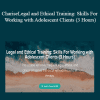

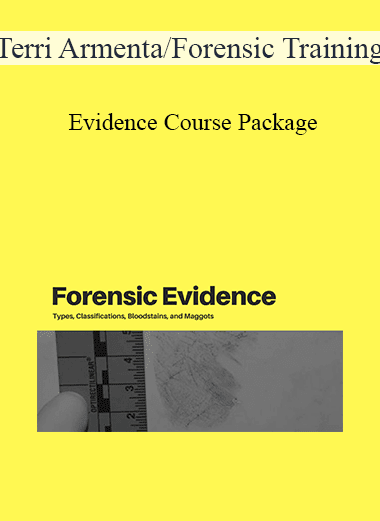
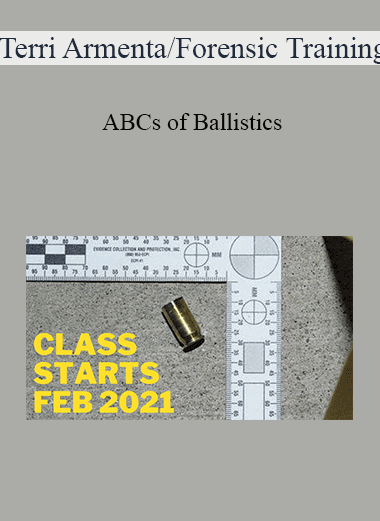
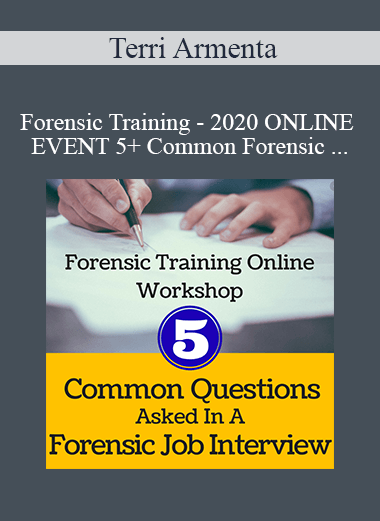
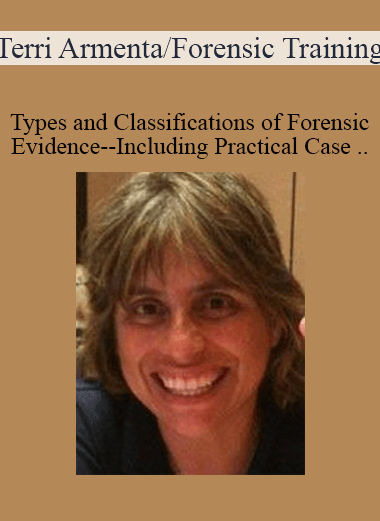
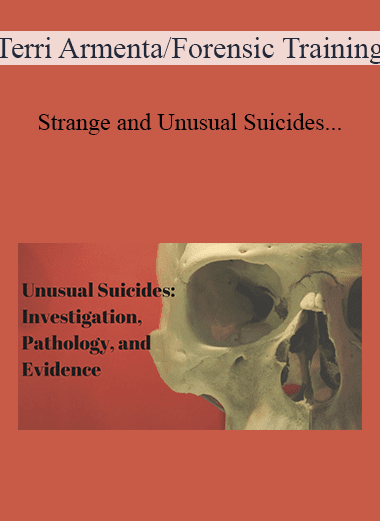
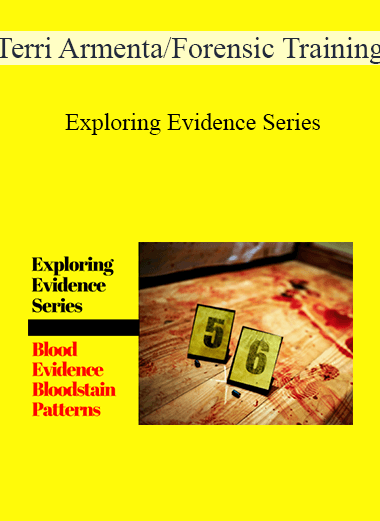
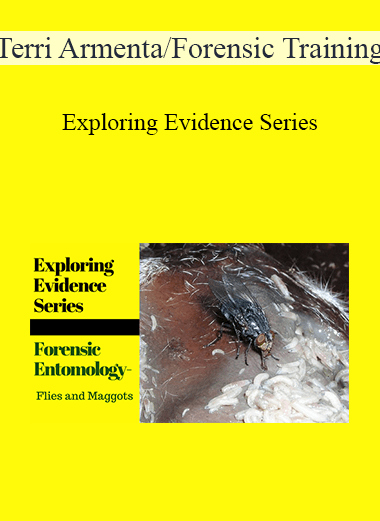
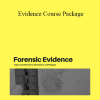
9 reviews for Terri Armenta/Forensic Training – Evidence Course Package: Types and Classifications of Forensic Evidence+Bloodstain Patterns+Forensic Entomology
There are no reviews yet.